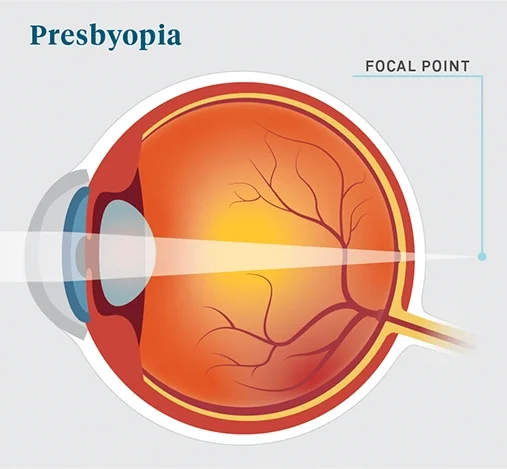Struggling to Read the Fine Print? It Might Be Presbyopia
If you find yourself holding your phone at arm’s length or needing better lighting to read menus, you’re not alone. These are common signs of presbyopia, an age-related change in vision that affects almost everyone over the age of 40.
At London Eye & Retina, we offer personalised solutions for presbyopia based on your lifestyle, vision goals, and long-term eye health. With the right support, you can continue to enjoy clear vision at all distances.
What Is Presbyopia?
Presbyopia is a natural loss of the eye’s ability to focus on near objects. It happens as the lens inside the eye gradually becomes less flexible, making it harder to adjust focus between far and near.
Unlike myopia (short-sightedness) or hyperopia (farsightedness), presbyopia is related to ageing and not caused by changes in the shape of the eyeball.
What Causes It?
Presbyopia typically begins between ages 40 and 45, and progresses slowly over time. It occurs due to:
- Hardening of the lens inside the eye
- Loss of elasticity in the focusing muscles
- Reduced lens accommodation, making near vision more difficult
It affects everyone, regardless of whether you’ve previously worn glasses or had perfect distance vision.
Common Symptoms
You may notice signs of presbyopia when performing tasks that require near vision, such as:
- Blurred vision when reading or using your phone
- Needing to hold reading material farther away
- Eye fatigue after prolonged close-up tasks
- Headaches or discomfort with reading or sewing
- Difficulty seeing in dim lighting
Many people first become aware of presbyopia when reading becomes uncomfortable, especially after a long day.
How Is Presbyopia Diagnosed?
Presbyopia can be detected through a standard eye exam. At London Eye & Retina, we assess:
- Visual acuity for both distance and near
- Refraction testing to determine your prescription
- Binocular vision and eye coordination
- Overall eye health, especially in adults over 40
If you already wear glasses or contact lenses for another refractive error (e.g. myopia or astigmatism), we can help adjust your prescription to include near correction as well.
What Are the Correction Options?
Presbyopia cannot be reversed, but it can be managed easily with several vision correction options:
1. Reading Glasses
Simple solution for people who only need help with near vision.
2. Bifocal or Progressive Lenses
Offer a seamless transition between distance and near vision in a single pair of glasses
3. Contact Lenses
Options include multifocal lenses, monovision correction, or modified monovision, depending on your eye dominance and preference.
4. Laser Vision Correction
Procedures such as LASIK or PresbyLASIK may be suitable for selected candidates. These aim to improve range of focus but may not eliminate the need for reading glasses entirely.
5. Intraocular Lens (IOL) Options
If you are undergoing cataract surgery, multifocal or extended depth-of-focus IOLs may offer improved near and distance vision without glasses.
We’ll guide you through the pros and cons of each, and help you decide based on your daily routines, screen use, and preferences.
Living with Presbyopia
Presbyopia is a normal part of ageing, but that doesn’t mean you have to accept constant visual discomfort. With the right correction, most people adapt quickly and regain visual comfort for near tasks.
Regular eye check-ups ensure your prescription remains accurate and help detect other age-related eye conditions early, such as cataracts or glaucoma.
See Clearly, At Every Distance
If reading small text has become a daily struggle, it may be time to check for presbyopia. There are many ways to restore comfortable near vision, and we’re here to help you find the one that fits your life.
Book a presbyopia assessment at London Eye & Retina to explore your personalised options.
Clear, Comfortable Vision, No More Squinting


